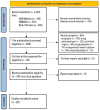A Chronological Overview of Using Deep Learning for Leukemia Detection: A Scoping Review
- PMID: 38947677
- PMCID: PMC11214573
- DOI: 10.7759/cureus.61379
A Chronological Overview of Using Deep Learning for Leukemia Detection: A Scoping Review
Abstract
Leukemia is a rare but fatal cancer of the blood. This cancer arises from abnormal bone marrow cells and requires prompt diagnosis for effective treatment and positive patient prognosis. Traditional diagnostic methods (e.g., microscopy, flow cytometry, and biopsy) pose challenges in both accuracy and time, demanding an inquisition on the development and use of deep learning (DL) models, such as convolutional neural networks (CNN), which could allow for a faster and more exact diagnosis. Using specific, objective criteria, DL might hold promise as a tool for physicians to diagnose leukemia. The purpose of this review was to report the relevant available published literature on using DL to diagnose leukemia. Using the Preferred Reporting Items for Systematic Reviews and Meta-Analyses (PRISMA) guidelines, articles published between 2010 and 2023 were searched using Embase, Ovid MEDLINE, and Web of Science, searching the terms "leukemia" AND "deep learning" or "artificial neural network" OR "neural network" AND "diagnosis" OR "detection." After screening retrieved articles using pre-determined eligibility criteria, 20 articles were included in the final review and reported chronologically due to the nascent nature of the phenomenon. The initial studies laid the groundwork for subsequent innovations, illustrating the transition from specialized methods to more generalized approaches capitalizing on DL technologies for leukemia detection. This summary of recent DL models revealed a paradigm shift toward integrated architectures, resulting in notable enhancements in accuracy and efficiency. The continuous refinement of models and techniques, coupled with an emphasis on simplicity and efficiency, positions DL as a promising tool for leukemia detection. With the help of these neural networks, leukemia detection could be hastened, allowing for an improved long-term outlook and prognosis. Further research is warranted using real-life scenarios to confirm the suggested transformative effects DL models could have on leukemia diagnosis.
Keywords: acute lymphoblastic leukemia (all); artificial intelligence (ai); classification; convolutional neural networks (cnn); deep machine learning; detection; diagnosis; flow cytometry; neural networks.
Copyright © 2024, Rubinos Rodriguez et al.
Conflict of interest statement
Conflicts of interest: In compliance with the ICMJE uniform disclosure form, all authors declare the following: Payment/services info: All authors have declared that no financial support was received from any organization for the submitted work. Financial relationships: All authors have declared that they have no financial relationships at present or within the previous three years with any organizations that might have an interest in the submitted work. Other relationships: All authors have declared that there are no other relationships or activities that could appear to have influenced the submitted work.
Figures
References
-
- Acute leukemia: diagnosis and treatment. Blackburn LM, Bender S, Brown S. Semin Oncol Nurs. 2019;35:150950. - PubMed
-
- Deep learning for visual understanding: a review. Guo Y, Liu Y, Oerlemans A, Lao S, Wu S, Lew MS. Neurocomputing. 2016;187:27–48.
Publication types
LinkOut - more resources
Full Text Sources

